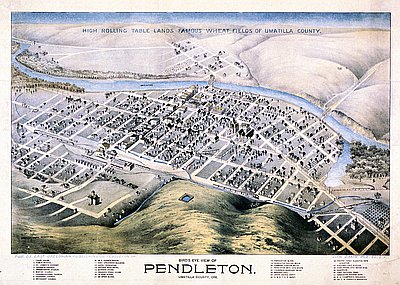Aside from the Columbia River, northeast Oregon is not much blessed with navigable waterways. The high expense of moving goods over roads, particularly mountainous ones, often hamstrung development. Gold did not weigh much, and cattle could walk to market. But bulky goods like wheat or lumber might cost more to ship by wagon than one could sell them for.
The railroad solved this problem. In 1883 Oregon at last got its transcontinental connection in a line that ran along the Columbia River. A year later a section running southeast from the river, cutting through the Blue Mountains, was completed. By 1900 several branch lines linked towns like Weston, Heppner, and Condon to the rest of the nation.
The railroads had a dramatic impact on the region’s agriculture. In 1897 Umatilla County had more than 200 miles of railroad and produced 44 percent of Oregon’s wheat. In 1880 150 people lived in Sherman County. In 1890 nearly 1,800 did. By 1900 Umatilla and Sherman counties ranked first and second, respectively, in Oregon wheat production.
The railroad not only marketed farmers’ crops, it carried to them bulky machinery that made production still more efficient. Massive combines drawn by up to forty horses dramatically cut the time that it took to harvest crops. Mechanical grain threshers removed a bottleneck in wheat production.
The economy remained more mixed to the south, in the Blue Mountains, where stock raising, mining, and logging were important.
Sawmills had dotted northeastern Oregon from 1862 forward. But these mills relied on streams to turn their machinery, a small and unreliable source of power. They could turn out about 1,000 board feet a day, enough to make a dent in local needs, but not enough to export to distant markets even if cheap transportation had been available. Steam mills arrived late in the 1870s, then the railroad. In 1889 a sawmill in Perry, near La Grande, could produce 100,000 board feet a day. Logging railroads, like the one linking Sumpter to Baker in 1891, improved access to extensive stands of pine.
Northeastern Oregon’s timber industry did not rival western Oregon’s by the century’s turn. But it had become a major part of the economy in and around La Grande and Baker City and in the Wallowa Mountains. The largest of these mills were often owned by people located well outside the region—though the companies often bore local names, perhaps to deflect criticism. Hence the Oregon Lumber Company, which employed some 500 men in and around Baker City in 1893, was owned by Utah businessmen.
The railroad prompted a revival of lode mining in the late nineteenth century, as cheap transportation eased the movement of heavy, gold-bearing ores. Sumpter boomed from 1896 to 1908, with a peak of 3,000 people. It had its own smelter for several years. The Bourne area was also very productive. The Cornucopia mines had the richest lodes from World War I until World War II. Silver mining grew in importance during these years, and copper mining in the Homestead District was profitable from 1916 through much of the 1920s. As with logging, most of the capital for these ventures came from outside the state, and the mines closed as abruptly as they had opened.
Expensive dredges that required crews of twenty to thirty people extracted most of the area’s gold from the mid-1910s into the 1950s. The massive dredges floated over streambeds that they churned through. They were most intensively used in the Sumpter Valley, where they sifted more than 2,600 acres.
Farmers had long lamented the area’s low rainfall. Irrigation promised to make right this deficit and to multiply agricultural productivity. Vale-area farmers diverted part of the Malheur River in the 1880s, though with indifferent success. The Warm Springs Dam, supported by the sale of bonds in the late 1910s, was a more concerted attempt to bring moisture to that area’s fields.
The most ambitious irrigation project began near Hermiston in 1905, shortly after passage of the U.S. Reclamation Act. By 1908 settlers were growing apples, pears, and other crops on their irrigated farms, and Hermiston, founded only three years earlier, had about 800 residents. But then rains became more scarce, and the federal government shrank the project dramatically.
Irrigation was supposed to be a boon for small, independent farm owners whose families provided the labor for their modest holdings. But the wheat farms of Umatilla and Sherman counties continued to increase in size and to be more capital intensive in the early twentieth century. Gas-powered tractors appeared on more prosperous farms in the 1920s. The new contraptions could do the work of several horses, and more quickly. They enabled farmers to plant cash crops in space once reserved for feeding their horses. But they cost a lot of money to keep running and, unlike horses, could not reproduce themselves.
Farm mechanization caused the population of northeastern Oregon’s wheat-producing areas to decline in the 1920s even as their productivity grew. Sherman County, for example, lost more than a third of its population between 1920 and 1940.
© David Peterson del Mar, 2005. Updated and revised by OHP staff, 2014.









